Consumer Behaviour and Lamborghini
VerifiedAdded on 2020/04/15
|16
|3395
|300
AI Summary
This assignment examines consumer behavior within the context of luxury car purchases, specifically focusing on Lamborghini. It delves into psychological factors like personality traits and Maslow's Hierarchy of Needs, as well as social influences such as reference groups and cultural trends. The assignment analyzes how these factors shape consumer decision-making processes when buying a high-end brand like Lamborghini. It also explores Lamborghini's target market segmentation strategies and the financial considerations involved in purchasing their vehicles.
Contribute Materials
Your contribution can guide someone’s learning journey. Share your
documents today.
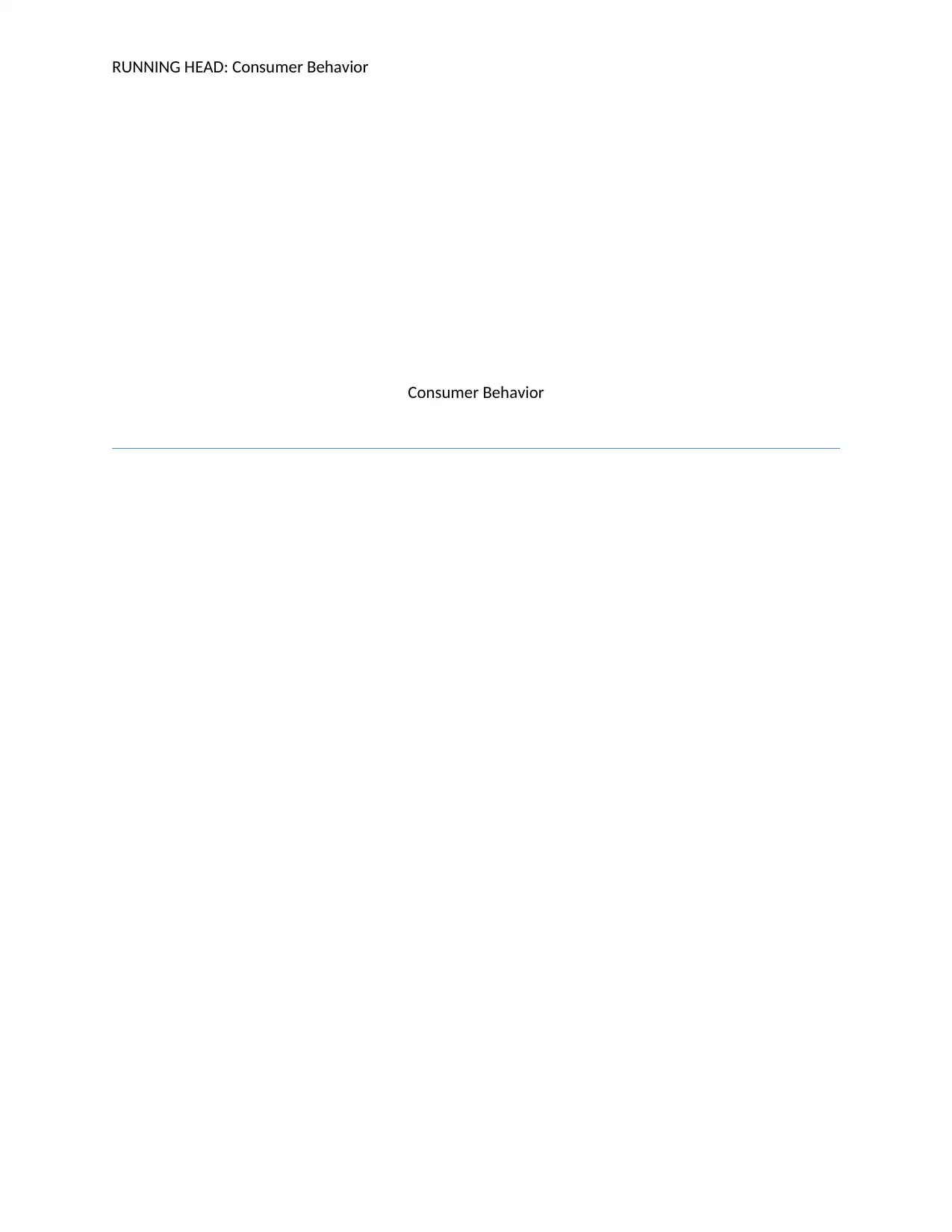
RUNNING HEAD: Consumer Behavior
Consumer Behavior
Consumer Behavior
Secure Best Marks with AI Grader
Need help grading? Try our AI Grader for instant feedback on your assignments.
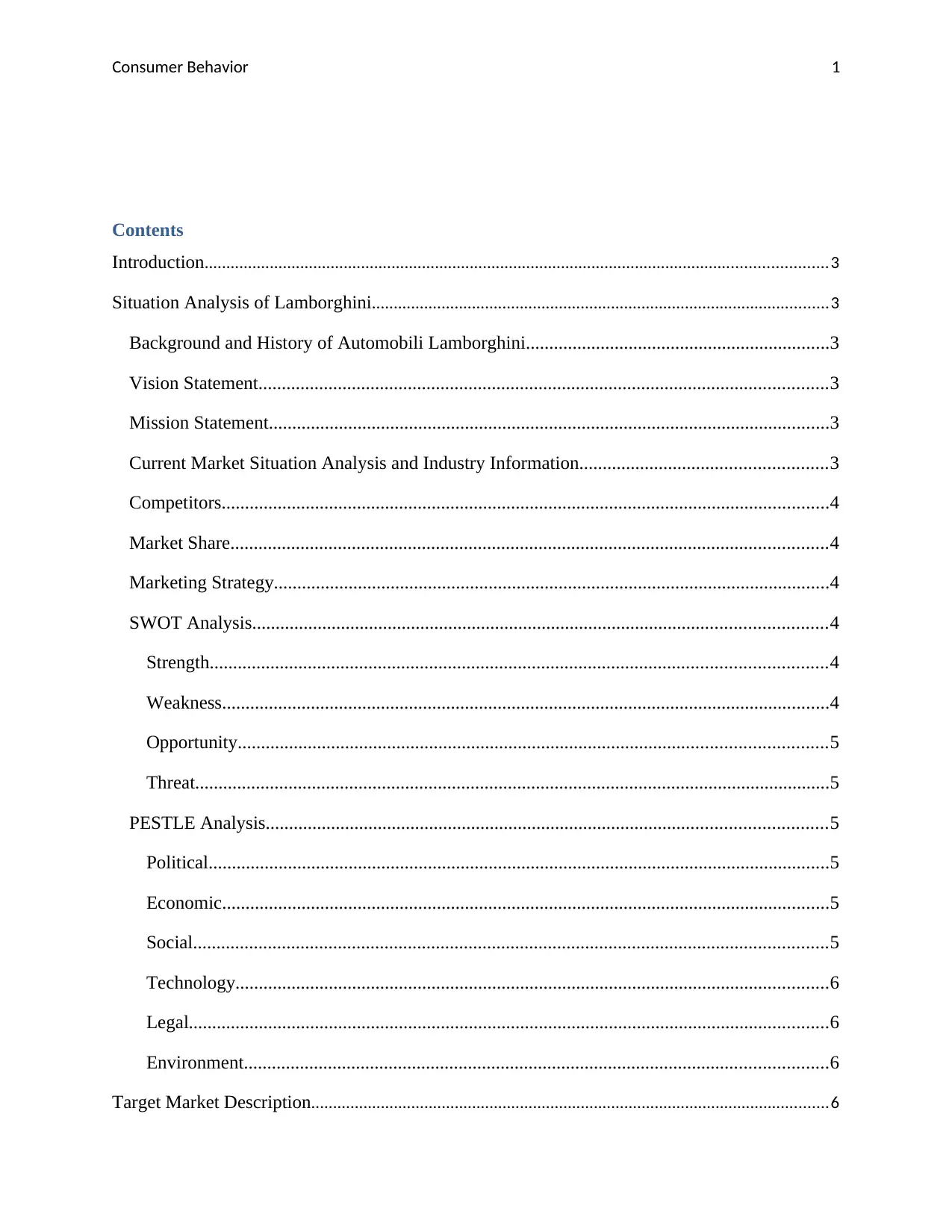
Consumer Behavior 1
Contents
Introduction...............................................................................................................................................3
Situation Analysis of Lamborghini.........................................................................................................3
Background and History of Automobili Lamborghini.................................................................3
Vision Statement..........................................................................................................................3
Mission Statement........................................................................................................................3
Current Market Situation Analysis and Industry Information.....................................................3
Competitors..................................................................................................................................4
Market Share................................................................................................................................4
Marketing Strategy.......................................................................................................................4
SWOT Analysis...........................................................................................................................4
Strength....................................................................................................................................4
Weakness..................................................................................................................................4
Opportunity..............................................................................................................................5
Threat........................................................................................................................................5
PESTLE Analysis........................................................................................................................5
Political.....................................................................................................................................5
Economic..................................................................................................................................5
Social........................................................................................................................................5
Technology...............................................................................................................................6
Legal.........................................................................................................................................6
Environment.............................................................................................................................6
Target Market Description.......................................................................................................................6
Contents
Introduction...............................................................................................................................................3
Situation Analysis of Lamborghini.........................................................................................................3
Background and History of Automobili Lamborghini.................................................................3
Vision Statement..........................................................................................................................3
Mission Statement........................................................................................................................3
Current Market Situation Analysis and Industry Information.....................................................3
Competitors..................................................................................................................................4
Market Share................................................................................................................................4
Marketing Strategy.......................................................................................................................4
SWOT Analysis...........................................................................................................................4
Strength....................................................................................................................................4
Weakness..................................................................................................................................4
Opportunity..............................................................................................................................5
Threat........................................................................................................................................5
PESTLE Analysis........................................................................................................................5
Political.....................................................................................................................................5
Economic..................................................................................................................................5
Social........................................................................................................................................5
Technology...............................................................................................................................6
Legal.........................................................................................................................................6
Environment.............................................................................................................................6
Target Market Description.......................................................................................................................6
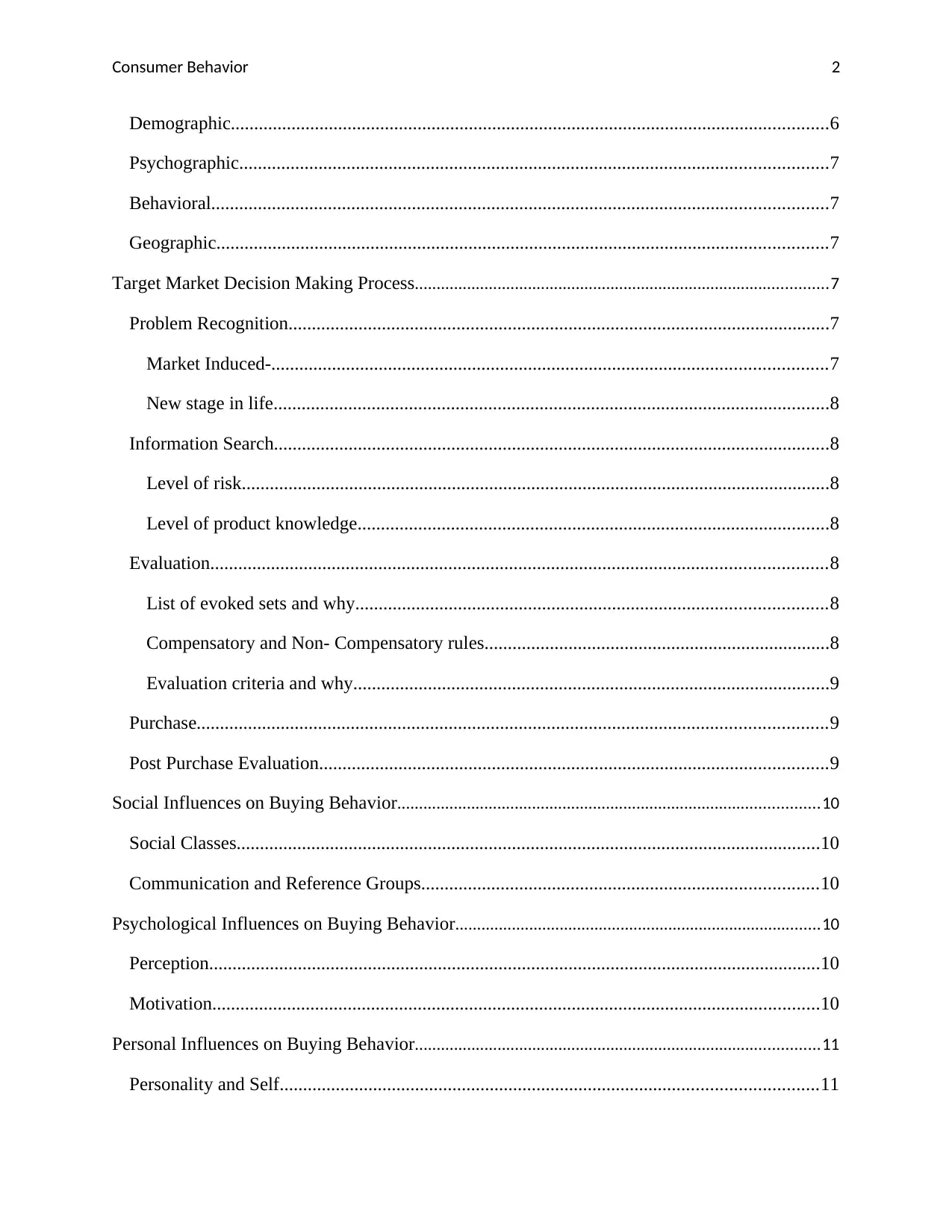
Consumer Behavior 2
Demographic................................................................................................................................6
Psychographic..............................................................................................................................7
Behavioral....................................................................................................................................7
Geographic...................................................................................................................................7
Target Market Decision Making Process...............................................................................................7
Problem Recognition....................................................................................................................7
Market Induced-.......................................................................................................................7
New stage in life.......................................................................................................................8
Information Search.......................................................................................................................8
Level of risk..............................................................................................................................8
Level of product knowledge.....................................................................................................8
Evaluation....................................................................................................................................8
List of evoked sets and why.....................................................................................................8
Compensatory and Non- Compensatory rules..........................................................................8
Evaluation criteria and why......................................................................................................9
Purchase.......................................................................................................................................9
Post Purchase Evaluation.............................................................................................................9
Social Influences on Buying Behavior.................................................................................................10
Social Classes.............................................................................................................................10
Communication and Reference Groups.....................................................................................10
Psychological Influences on Buying Behavior....................................................................................10
Perception...................................................................................................................................10
Motivation..................................................................................................................................10
Personal Influences on Buying Behavior.............................................................................................11
Personality and Self...................................................................................................................11
Demographic................................................................................................................................6
Psychographic..............................................................................................................................7
Behavioral....................................................................................................................................7
Geographic...................................................................................................................................7
Target Market Decision Making Process...............................................................................................7
Problem Recognition....................................................................................................................7
Market Induced-.......................................................................................................................7
New stage in life.......................................................................................................................8
Information Search.......................................................................................................................8
Level of risk..............................................................................................................................8
Level of product knowledge.....................................................................................................8
Evaluation....................................................................................................................................8
List of evoked sets and why.....................................................................................................8
Compensatory and Non- Compensatory rules..........................................................................8
Evaluation criteria and why......................................................................................................9
Purchase.......................................................................................................................................9
Post Purchase Evaluation.............................................................................................................9
Social Influences on Buying Behavior.................................................................................................10
Social Classes.............................................................................................................................10
Communication and Reference Groups.....................................................................................10
Psychological Influences on Buying Behavior....................................................................................10
Perception...................................................................................................................................10
Motivation..................................................................................................................................10
Personal Influences on Buying Behavior.............................................................................................11
Personality and Self...................................................................................................................11
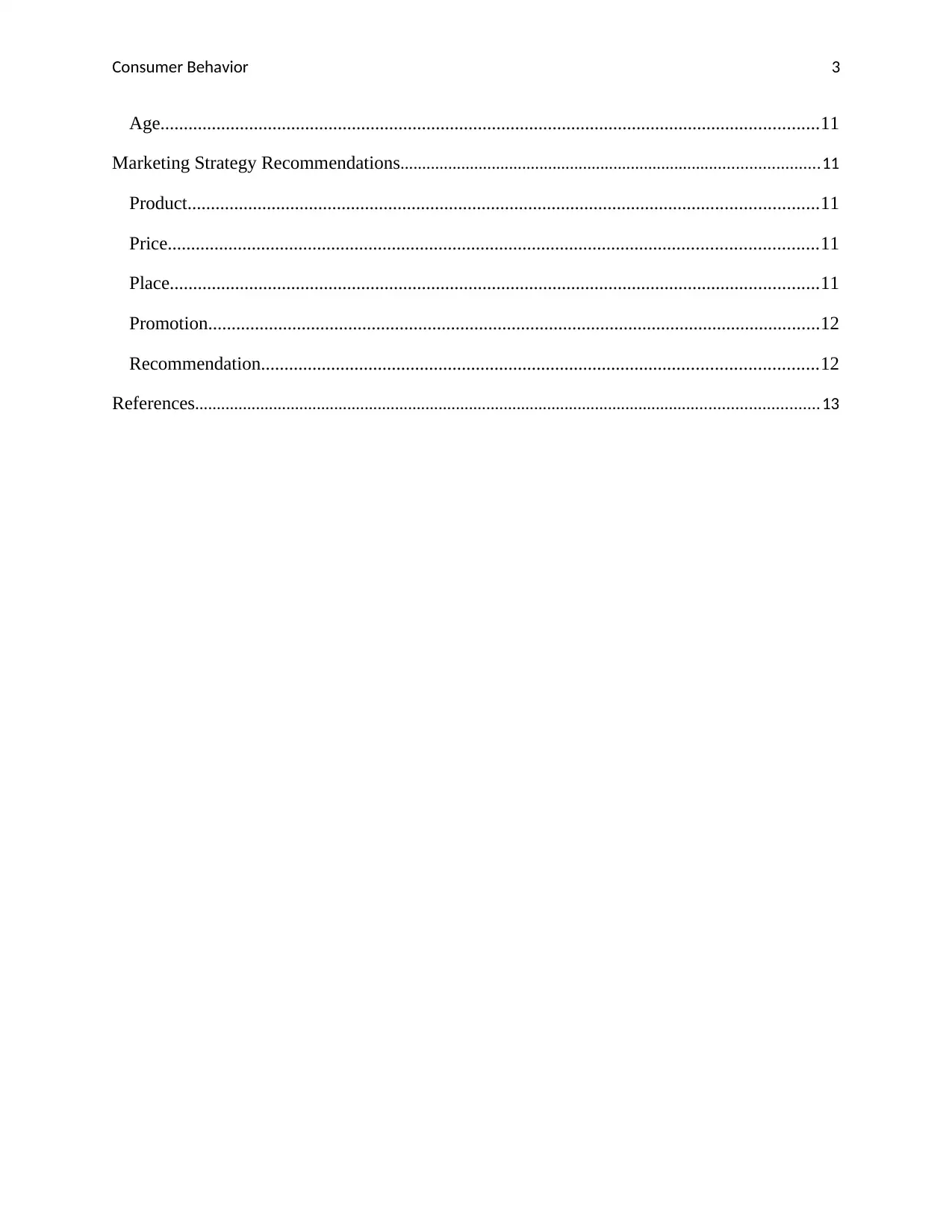
Consumer Behavior 3
Age.............................................................................................................................................11
Marketing Strategy Recommendations................................................................................................11
Product.......................................................................................................................................11
Price...........................................................................................................................................11
Place...........................................................................................................................................11
Promotion...................................................................................................................................12
Recommendation.......................................................................................................................12
References...............................................................................................................................................13
Age.............................................................................................................................................11
Marketing Strategy Recommendations................................................................................................11
Product.......................................................................................................................................11
Price...........................................................................................................................................11
Place...........................................................................................................................................11
Promotion...................................................................................................................................12
Recommendation.......................................................................................................................12
References...............................................................................................................................................13
Secure Best Marks with AI Grader
Need help grading? Try our AI Grader for instant feedback on your assignments.
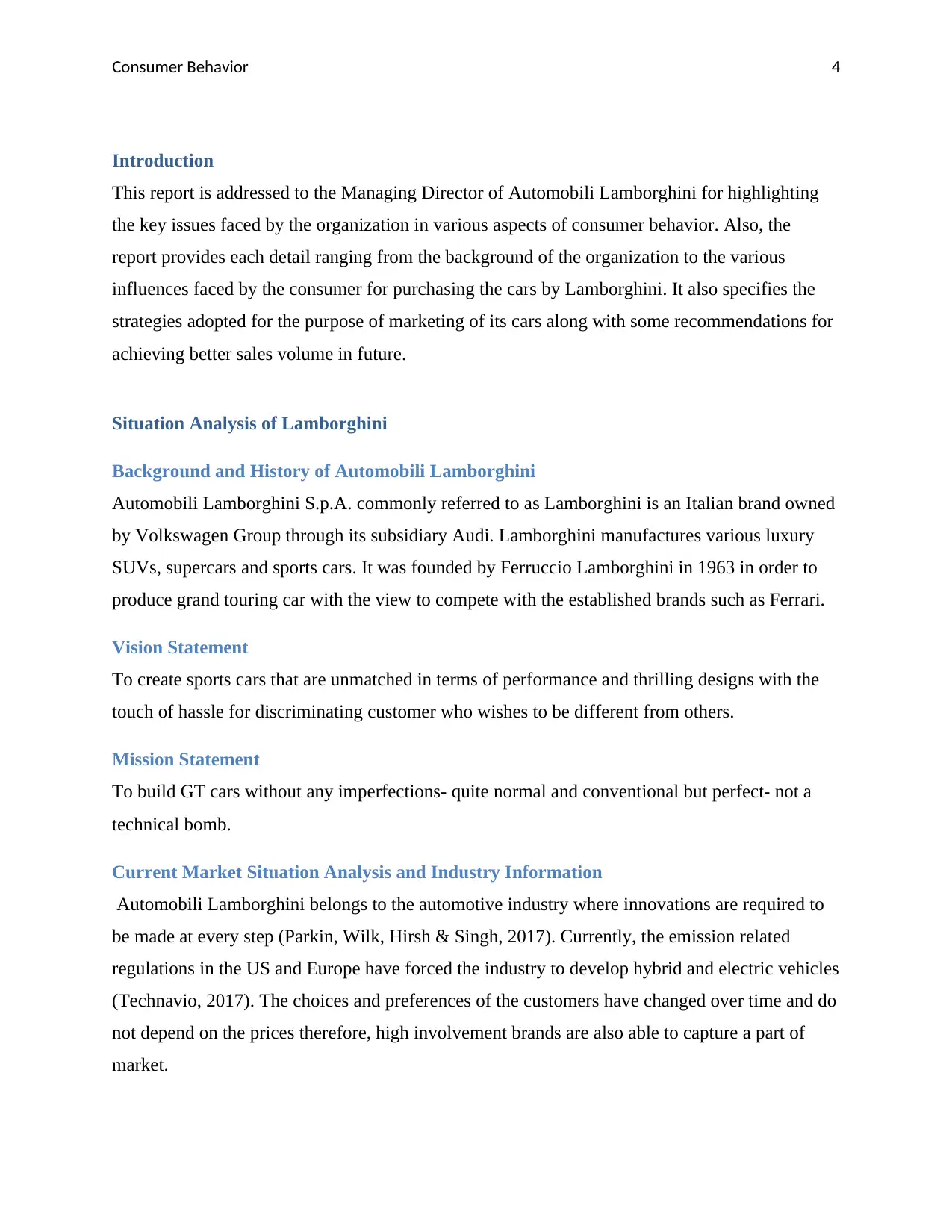
Consumer Behavior 4
Introduction
This report is addressed to the Managing Director of Automobili Lamborghini for highlighting
the key issues faced by the organization in various aspects of consumer behavior. Also, the
report provides each detail ranging from the background of the organization to the various
influences faced by the consumer for purchasing the cars by Lamborghini. It also specifies the
strategies adopted for the purpose of marketing of its cars along with some recommendations for
achieving better sales volume in future.
Situation Analysis of Lamborghini
Background and History of Automobili Lamborghini
Automobili Lamborghini S.p.A. commonly referred to as Lamborghini is an Italian brand owned
by Volkswagen Group through its subsidiary Audi. Lamborghini manufactures various luxury
SUVs, supercars and sports cars. It was founded by Ferruccio Lamborghini in 1963 in order to
produce grand touring car with the view to compete with the established brands such as Ferrari.
Vision Statement
To create sports cars that are unmatched in terms of performance and thrilling designs with the
touch of hassle for discriminating customer who wishes to be different from others.
Mission Statement
To build GT cars without any imperfections- quite normal and conventional but perfect- not a
technical bomb.
Current Market Situation Analysis and Industry Information
Automobili Lamborghini belongs to the automotive industry where innovations are required to
be made at every step (Parkin, Wilk, Hirsh & Singh, 2017). Currently, the emission related
regulations in the US and Europe have forced the industry to develop hybrid and electric vehicles
(Technavio, 2017). The choices and preferences of the customers have changed over time and do
not depend on the prices therefore, high involvement brands are also able to capture a part of
market.
Introduction
This report is addressed to the Managing Director of Automobili Lamborghini for highlighting
the key issues faced by the organization in various aspects of consumer behavior. Also, the
report provides each detail ranging from the background of the organization to the various
influences faced by the consumer for purchasing the cars by Lamborghini. It also specifies the
strategies adopted for the purpose of marketing of its cars along with some recommendations for
achieving better sales volume in future.
Situation Analysis of Lamborghini
Background and History of Automobili Lamborghini
Automobili Lamborghini S.p.A. commonly referred to as Lamborghini is an Italian brand owned
by Volkswagen Group through its subsidiary Audi. Lamborghini manufactures various luxury
SUVs, supercars and sports cars. It was founded by Ferruccio Lamborghini in 1963 in order to
produce grand touring car with the view to compete with the established brands such as Ferrari.
Vision Statement
To create sports cars that are unmatched in terms of performance and thrilling designs with the
touch of hassle for discriminating customer who wishes to be different from others.
Mission Statement
To build GT cars without any imperfections- quite normal and conventional but perfect- not a
technical bomb.
Current Market Situation Analysis and Industry Information
Automobili Lamborghini belongs to the automotive industry where innovations are required to
be made at every step (Parkin, Wilk, Hirsh & Singh, 2017). Currently, the emission related
regulations in the US and Europe have forced the industry to develop hybrid and electric vehicles
(Technavio, 2017). The choices and preferences of the customers have changed over time and do
not depend on the prices therefore, high involvement brands are also able to capture a part of
market.
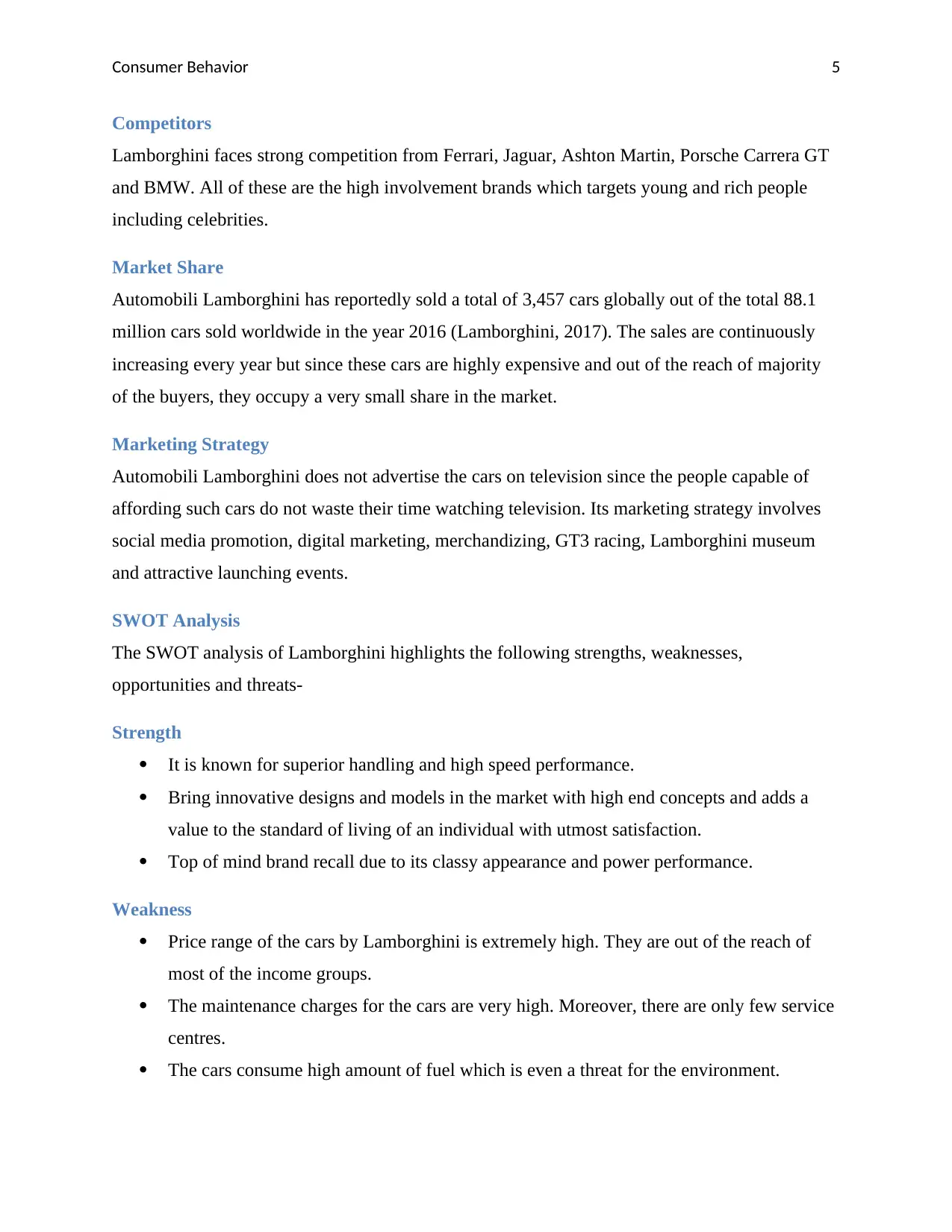
Consumer Behavior 5
Competitors
Lamborghini faces strong competition from Ferrari, Jaguar, Ashton Martin, Porsche Carrera GT
and BMW. All of these are the high involvement brands which targets young and rich people
including celebrities.
Market Share
Automobili Lamborghini has reportedly sold a total of 3,457 cars globally out of the total 88.1
million cars sold worldwide in the year 2016 (Lamborghini, 2017). The sales are continuously
increasing every year but since these cars are highly expensive and out of the reach of majority
of the buyers, they occupy a very small share in the market.
Marketing Strategy
Automobili Lamborghini does not advertise the cars on television since the people capable of
affording such cars do not waste their time watching television. Its marketing strategy involves
social media promotion, digital marketing, merchandizing, GT3 racing, Lamborghini museum
and attractive launching events.
SWOT Analysis
The SWOT analysis of Lamborghini highlights the following strengths, weaknesses,
opportunities and threats-
Strength
It is known for superior handling and high speed performance.
Bring innovative designs and models in the market with high end concepts and adds a
value to the standard of living of an individual with utmost satisfaction.
Top of mind brand recall due to its classy appearance and power performance.
Weakness
Price range of the cars by Lamborghini is extremely high. They are out of the reach of
most of the income groups.
The maintenance charges for the cars are very high. Moreover, there are only few service
centres.
The cars consume high amount of fuel which is even a threat for the environment.
Competitors
Lamborghini faces strong competition from Ferrari, Jaguar, Ashton Martin, Porsche Carrera GT
and BMW. All of these are the high involvement brands which targets young and rich people
including celebrities.
Market Share
Automobili Lamborghini has reportedly sold a total of 3,457 cars globally out of the total 88.1
million cars sold worldwide in the year 2016 (Lamborghini, 2017). The sales are continuously
increasing every year but since these cars are highly expensive and out of the reach of majority
of the buyers, they occupy a very small share in the market.
Marketing Strategy
Automobili Lamborghini does not advertise the cars on television since the people capable of
affording such cars do not waste their time watching television. Its marketing strategy involves
social media promotion, digital marketing, merchandizing, GT3 racing, Lamborghini museum
and attractive launching events.
SWOT Analysis
The SWOT analysis of Lamborghini highlights the following strengths, weaknesses,
opportunities and threats-
Strength
It is known for superior handling and high speed performance.
Bring innovative designs and models in the market with high end concepts and adds a
value to the standard of living of an individual with utmost satisfaction.
Top of mind brand recall due to its classy appearance and power performance.
Weakness
Price range of the cars by Lamborghini is extremely high. They are out of the reach of
most of the income groups.
The maintenance charges for the cars are very high. Moreover, there are only few service
centres.
The cars consume high amount of fuel which is even a threat for the environment.
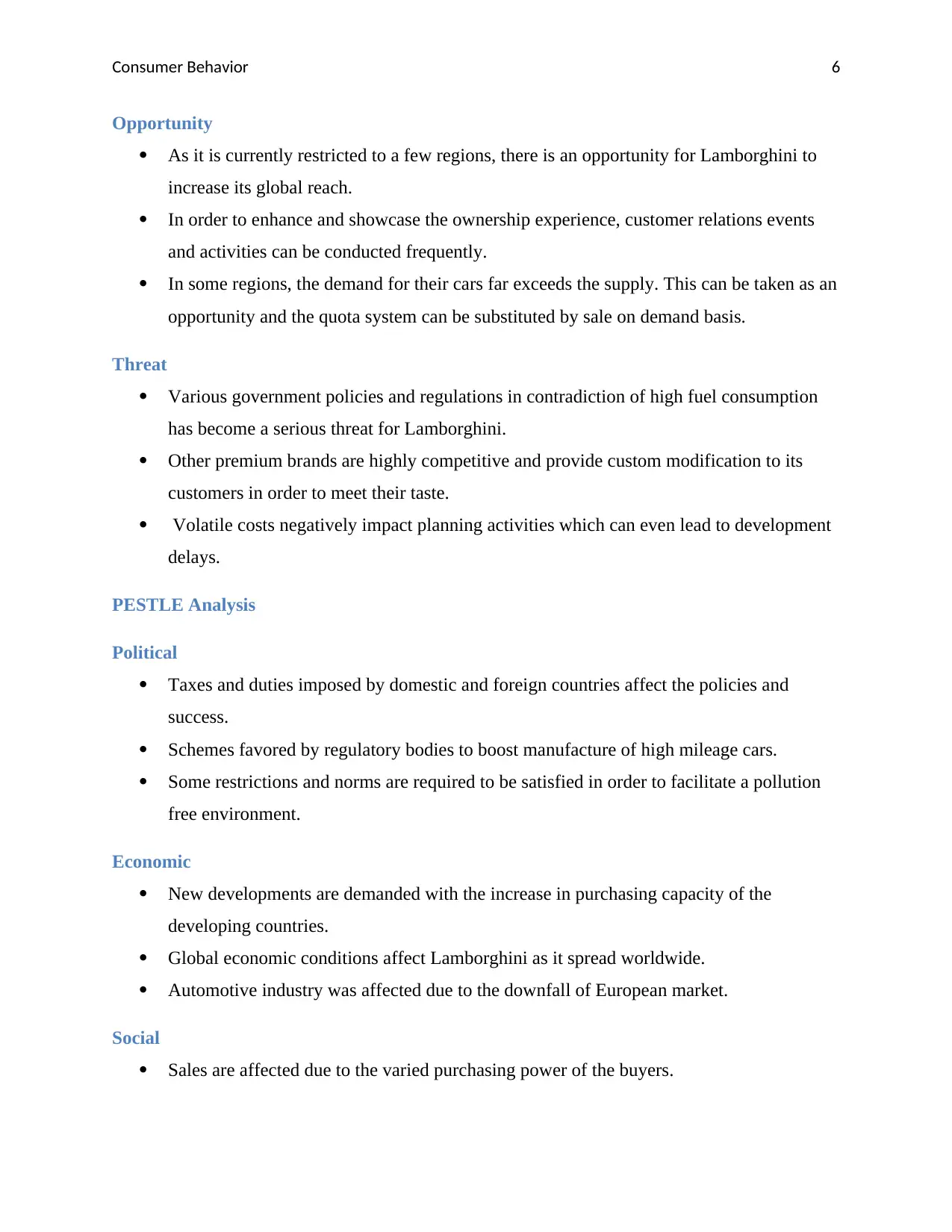
Consumer Behavior 6
Opportunity
As it is currently restricted to a few regions, there is an opportunity for Lamborghini to
increase its global reach.
In order to enhance and showcase the ownership experience, customer relations events
and activities can be conducted frequently.
In some regions, the demand for their cars far exceeds the supply. This can be taken as an
opportunity and the quota system can be substituted by sale on demand basis.
Threat
Various government policies and regulations in contradiction of high fuel consumption
has become a serious threat for Lamborghini.
Other premium brands are highly competitive and provide custom modification to its
customers in order to meet their taste.
Volatile costs negatively impact planning activities which can even lead to development
delays.
PESTLE Analysis
Political
Taxes and duties imposed by domestic and foreign countries affect the policies and
success.
Schemes favored by regulatory bodies to boost manufacture of high mileage cars.
Some restrictions and norms are required to be satisfied in order to facilitate a pollution
free environment.
Economic
New developments are demanded with the increase in purchasing capacity of the
developing countries.
Global economic conditions affect Lamborghini as it spread worldwide.
Automotive industry was affected due to the downfall of European market.
Social
Sales are affected due to the varied purchasing power of the buyers.
Opportunity
As it is currently restricted to a few regions, there is an opportunity for Lamborghini to
increase its global reach.
In order to enhance and showcase the ownership experience, customer relations events
and activities can be conducted frequently.
In some regions, the demand for their cars far exceeds the supply. This can be taken as an
opportunity and the quota system can be substituted by sale on demand basis.
Threat
Various government policies and regulations in contradiction of high fuel consumption
has become a serious threat for Lamborghini.
Other premium brands are highly competitive and provide custom modification to its
customers in order to meet their taste.
Volatile costs negatively impact planning activities which can even lead to development
delays.
PESTLE Analysis
Political
Taxes and duties imposed by domestic and foreign countries affect the policies and
success.
Schemes favored by regulatory bodies to boost manufacture of high mileage cars.
Some restrictions and norms are required to be satisfied in order to facilitate a pollution
free environment.
Economic
New developments are demanded with the increase in purchasing capacity of the
developing countries.
Global economic conditions affect Lamborghini as it spread worldwide.
Automotive industry was affected due to the downfall of European market.
Social
Sales are affected due to the varied purchasing power of the buyers.
Paraphrase This Document
Need a fresh take? Get an instant paraphrase of this document with our AI Paraphraser
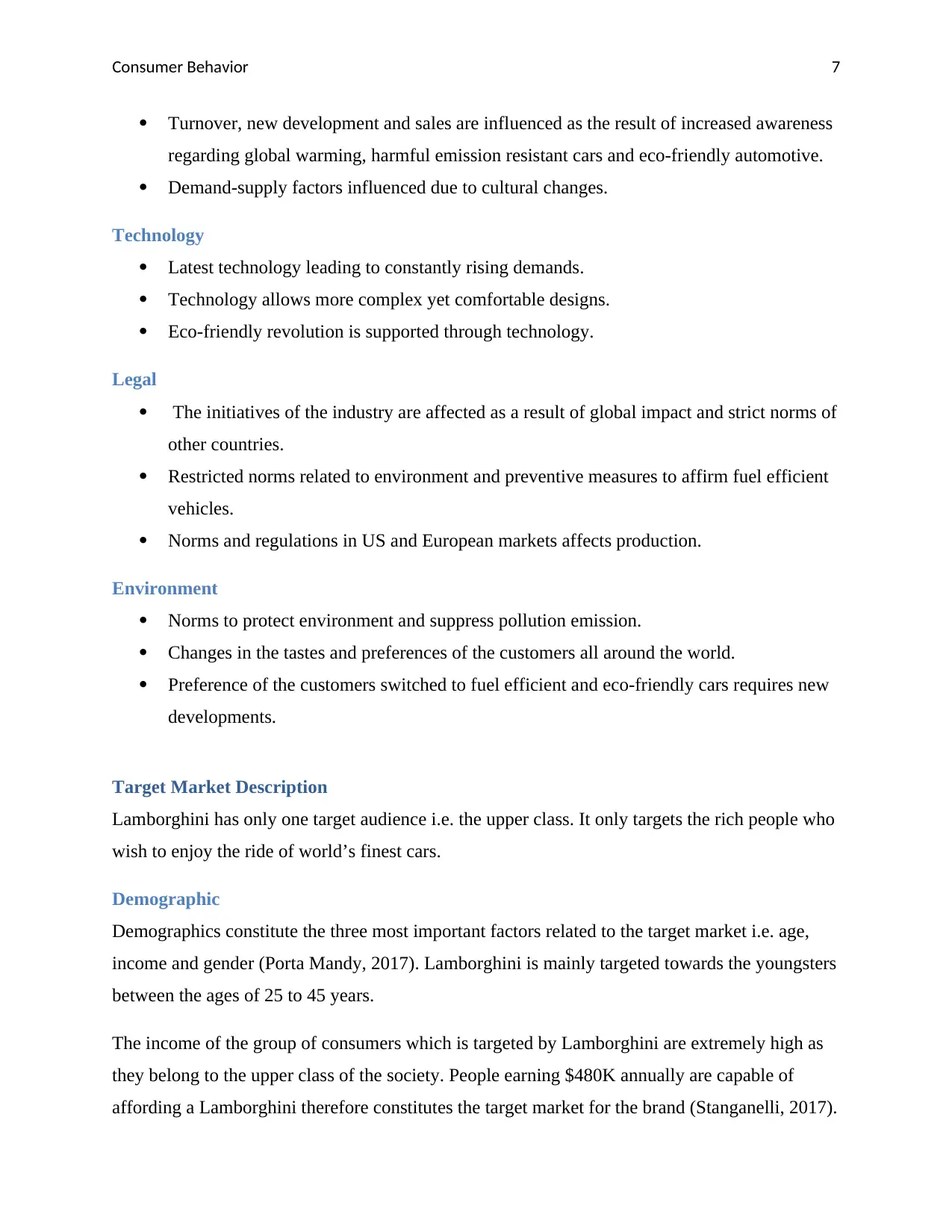
Consumer Behavior 7
Turnover, new development and sales are influenced as the result of increased awareness
regarding global warming, harmful emission resistant cars and eco-friendly automotive.
Demand-supply factors influenced due to cultural changes.
Technology
Latest technology leading to constantly rising demands.
Technology allows more complex yet comfortable designs.
Eco-friendly revolution is supported through technology.
Legal
The initiatives of the industry are affected as a result of global impact and strict norms of
other countries.
Restricted norms related to environment and preventive measures to affirm fuel efficient
vehicles.
Norms and regulations in US and European markets affects production.
Environment
Norms to protect environment and suppress pollution emission.
Changes in the tastes and preferences of the customers all around the world.
Preference of the customers switched to fuel efficient and eco-friendly cars requires new
developments.
Target Market Description
Lamborghini has only one target audience i.e. the upper class. It only targets the rich people who
wish to enjoy the ride of world’s finest cars.
Demographic
Demographics constitute the three most important factors related to the target market i.e. age,
income and gender (Porta Mandy, 2017). Lamborghini is mainly targeted towards the youngsters
between the ages of 25 to 45 years.
The income of the group of consumers which is targeted by Lamborghini are extremely high as
they belong to the upper class of the society. People earning $480K annually are capable of
affording a Lamborghini therefore constitutes the target market for the brand (Stanganelli, 2017).
Turnover, new development and sales are influenced as the result of increased awareness
regarding global warming, harmful emission resistant cars and eco-friendly automotive.
Demand-supply factors influenced due to cultural changes.
Technology
Latest technology leading to constantly rising demands.
Technology allows more complex yet comfortable designs.
Eco-friendly revolution is supported through technology.
Legal
The initiatives of the industry are affected as a result of global impact and strict norms of
other countries.
Restricted norms related to environment and preventive measures to affirm fuel efficient
vehicles.
Norms and regulations in US and European markets affects production.
Environment
Norms to protect environment and suppress pollution emission.
Changes in the tastes and preferences of the customers all around the world.
Preference of the customers switched to fuel efficient and eco-friendly cars requires new
developments.
Target Market Description
Lamborghini has only one target audience i.e. the upper class. It only targets the rich people who
wish to enjoy the ride of world’s finest cars.
Demographic
Demographics constitute the three most important factors related to the target market i.e. age,
income and gender (Porta Mandy, 2017). Lamborghini is mainly targeted towards the youngsters
between the ages of 25 to 45 years.
The income of the group of consumers which is targeted by Lamborghini are extremely high as
they belong to the upper class of the society. People earning $480K annually are capable of
affording a Lamborghini therefore constitutes the target market for the brand (Stanganelli, 2017).
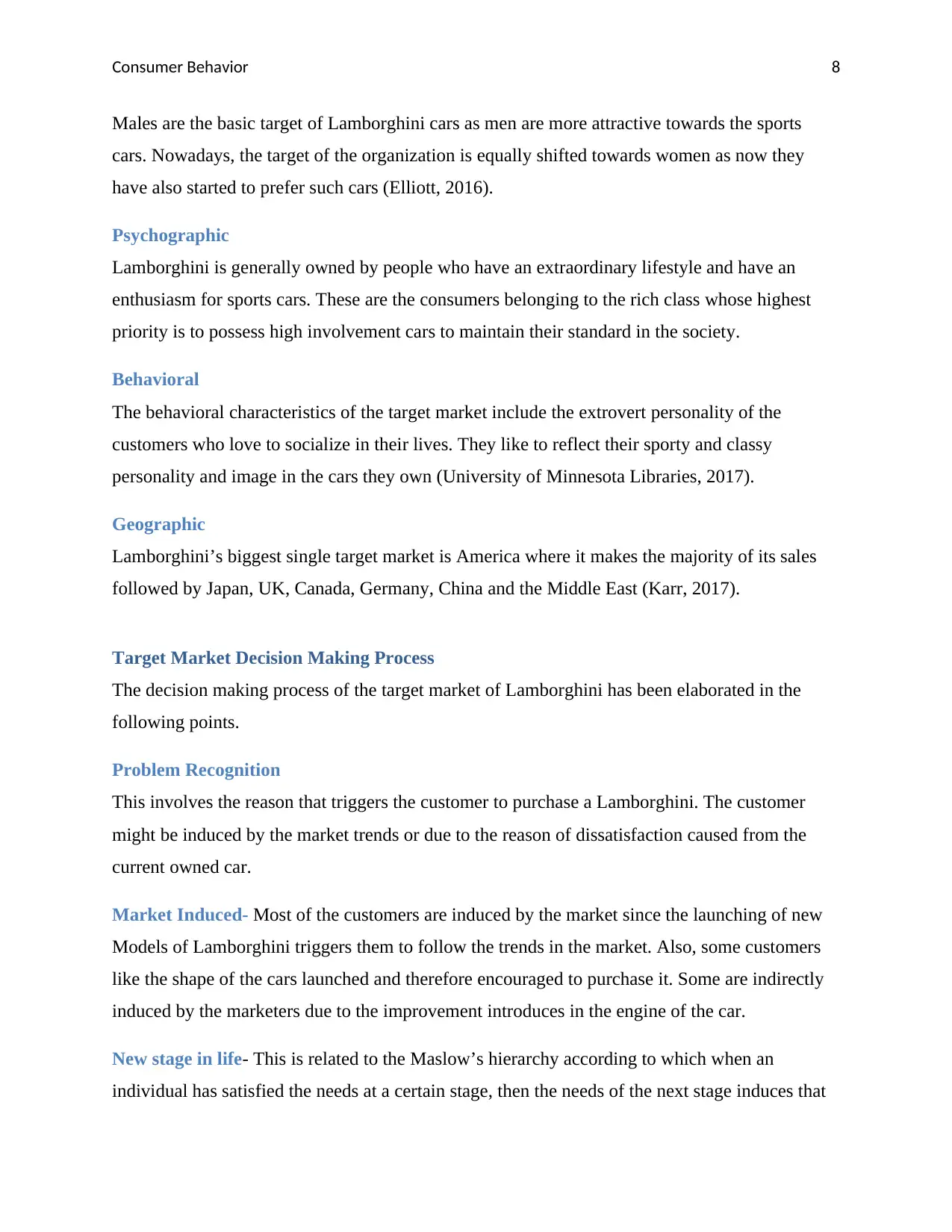
Consumer Behavior 8
Males are the basic target of Lamborghini cars as men are more attractive towards the sports
cars. Nowadays, the target of the organization is equally shifted towards women as now they
have also started to prefer such cars (Elliott, 2016).
Psychographic
Lamborghini is generally owned by people who have an extraordinary lifestyle and have an
enthusiasm for sports cars. These are the consumers belonging to the rich class whose highest
priority is to possess high involvement cars to maintain their standard in the society.
Behavioral
The behavioral characteristics of the target market include the extrovert personality of the
customers who love to socialize in their lives. They like to reflect their sporty and classy
personality and image in the cars they own (University of Minnesota Libraries, 2017).
Geographic
Lamborghini’s biggest single target market is America where it makes the majority of its sales
followed by Japan, UK, Canada, Germany, China and the Middle East (Karr, 2017).
Target Market Decision Making Process
The decision making process of the target market of Lamborghini has been elaborated in the
following points.
Problem Recognition
This involves the reason that triggers the customer to purchase a Lamborghini. The customer
might be induced by the market trends or due to the reason of dissatisfaction caused from the
current owned car.
Market Induced- Most of the customers are induced by the market since the launching of new
Models of Lamborghini triggers them to follow the trends in the market. Also, some customers
like the shape of the cars launched and therefore encouraged to purchase it. Some are indirectly
induced by the marketers due to the improvement introduces in the engine of the car.
New stage in life- This is related to the Maslow’s hierarchy according to which when an
individual has satisfied the needs at a certain stage, then the needs of the next stage induces that
Males are the basic target of Lamborghini cars as men are more attractive towards the sports
cars. Nowadays, the target of the organization is equally shifted towards women as now they
have also started to prefer such cars (Elliott, 2016).
Psychographic
Lamborghini is generally owned by people who have an extraordinary lifestyle and have an
enthusiasm for sports cars. These are the consumers belonging to the rich class whose highest
priority is to possess high involvement cars to maintain their standard in the society.
Behavioral
The behavioral characteristics of the target market include the extrovert personality of the
customers who love to socialize in their lives. They like to reflect their sporty and classy
personality and image in the cars they own (University of Minnesota Libraries, 2017).
Geographic
Lamborghini’s biggest single target market is America where it makes the majority of its sales
followed by Japan, UK, Canada, Germany, China and the Middle East (Karr, 2017).
Target Market Decision Making Process
The decision making process of the target market of Lamborghini has been elaborated in the
following points.
Problem Recognition
This involves the reason that triggers the customer to purchase a Lamborghini. The customer
might be induced by the market trends or due to the reason of dissatisfaction caused from the
current owned car.
Market Induced- Most of the customers are induced by the market since the launching of new
Models of Lamborghini triggers them to follow the trends in the market. Also, some customers
like the shape of the cars launched and therefore encouraged to purchase it. Some are indirectly
induced by the marketers due to the improvement introduces in the engine of the car.
New stage in life- This is related to the Maslow’s hierarchy according to which when an
individual has satisfied the needs at a certain stage, then the needs of the next stage induces that
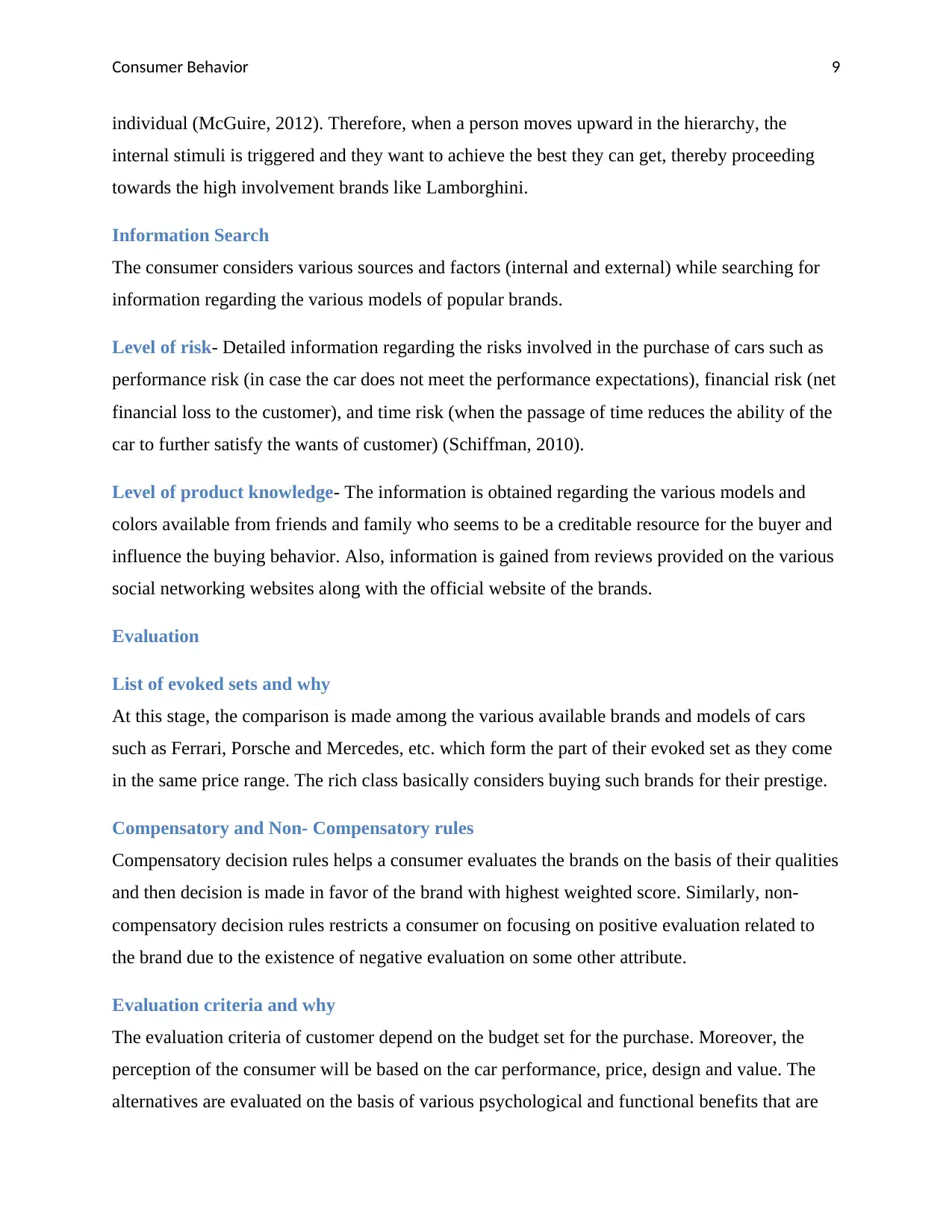
Consumer Behavior 9
individual (McGuire, 2012). Therefore, when a person moves upward in the hierarchy, the
internal stimuli is triggered and they want to achieve the best they can get, thereby proceeding
towards the high involvement brands like Lamborghini.
Information Search
The consumer considers various sources and factors (internal and external) while searching for
information regarding the various models of popular brands.
Level of risk- Detailed information regarding the risks involved in the purchase of cars such as
performance risk (in case the car does not meet the performance expectations), financial risk (net
financial loss to the customer), and time risk (when the passage of time reduces the ability of the
car to further satisfy the wants of customer) (Schiffman, 2010).
Level of product knowledge- The information is obtained regarding the various models and
colors available from friends and family who seems to be a creditable resource for the buyer and
influence the buying behavior. Also, information is gained from reviews provided on the various
social networking websites along with the official website of the brands.
Evaluation
List of evoked sets and why
At this stage, the comparison is made among the various available brands and models of cars
such as Ferrari, Porsche and Mercedes, etc. which form the part of their evoked set as they come
in the same price range. The rich class basically considers buying such brands for their prestige.
Compensatory and Non- Compensatory rules
Compensatory decision rules helps a consumer evaluates the brands on the basis of their qualities
and then decision is made in favor of the brand with highest weighted score. Similarly, non-
compensatory decision rules restricts a consumer on focusing on positive evaluation related to
the brand due to the existence of negative evaluation on some other attribute.
Evaluation criteria and why
The evaluation criteria of customer depend on the budget set for the purchase. Moreover, the
perception of the consumer will be based on the car performance, price, design and value. The
alternatives are evaluated on the basis of various psychological and functional benefits that are
individual (McGuire, 2012). Therefore, when a person moves upward in the hierarchy, the
internal stimuli is triggered and they want to achieve the best they can get, thereby proceeding
towards the high involvement brands like Lamborghini.
Information Search
The consumer considers various sources and factors (internal and external) while searching for
information regarding the various models of popular brands.
Level of risk- Detailed information regarding the risks involved in the purchase of cars such as
performance risk (in case the car does not meet the performance expectations), financial risk (net
financial loss to the customer), and time risk (when the passage of time reduces the ability of the
car to further satisfy the wants of customer) (Schiffman, 2010).
Level of product knowledge- The information is obtained regarding the various models and
colors available from friends and family who seems to be a creditable resource for the buyer and
influence the buying behavior. Also, information is gained from reviews provided on the various
social networking websites along with the official website of the brands.
Evaluation
List of evoked sets and why
At this stage, the comparison is made among the various available brands and models of cars
such as Ferrari, Porsche and Mercedes, etc. which form the part of their evoked set as they come
in the same price range. The rich class basically considers buying such brands for their prestige.
Compensatory and Non- Compensatory rules
Compensatory decision rules helps a consumer evaluates the brands on the basis of their qualities
and then decision is made in favor of the brand with highest weighted score. Similarly, non-
compensatory decision rules restricts a consumer on focusing on positive evaluation related to
the brand due to the existence of negative evaluation on some other attribute.
Evaluation criteria and why
The evaluation criteria of customer depend on the budget set for the purchase. Moreover, the
perception of the consumer will be based on the car performance, price, design and value. The
alternatives are evaluated on the basis of various psychological and functional benefits that are
Secure Best Marks with AI Grader
Need help grading? Try our AI Grader for instant feedback on your assignments.
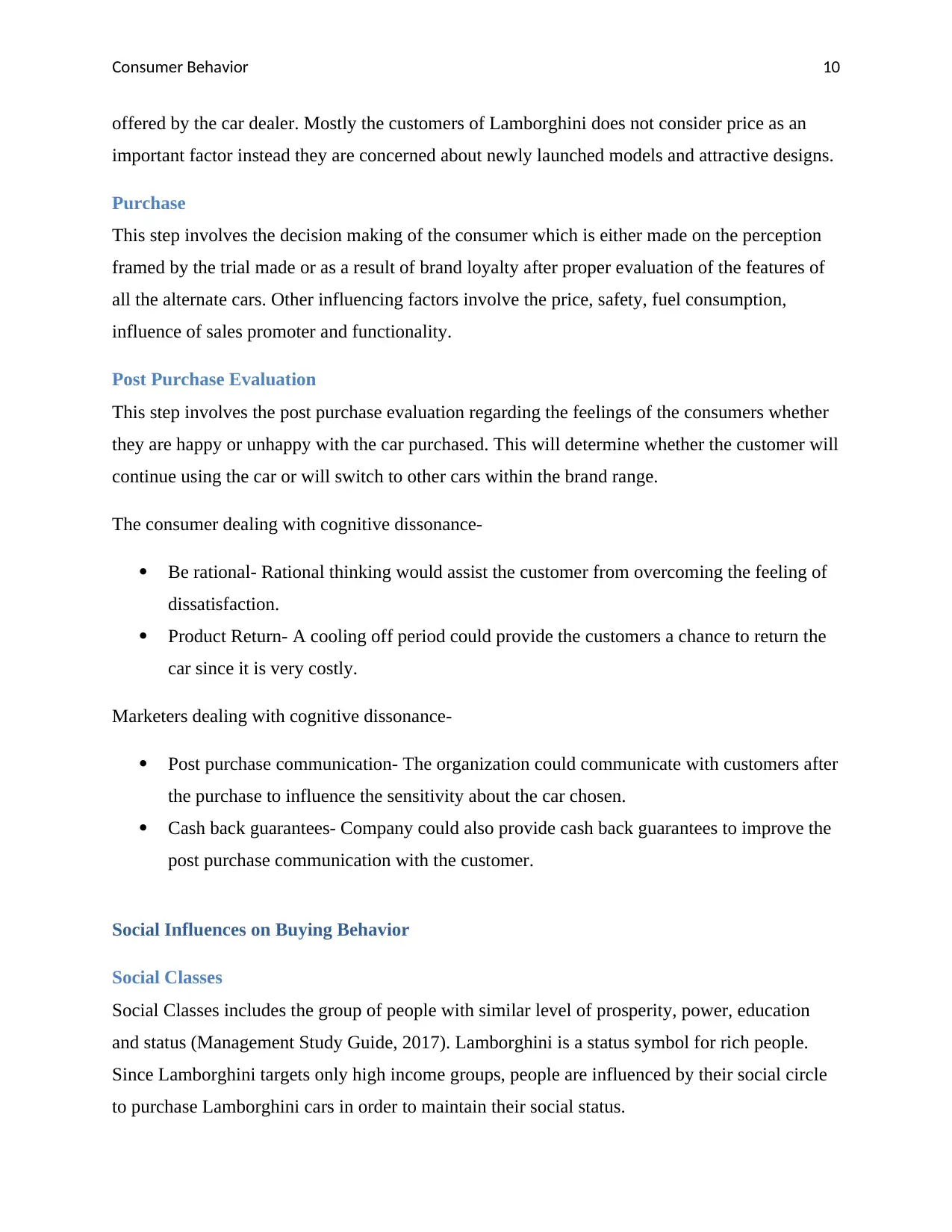
Consumer Behavior 10
offered by the car dealer. Mostly the customers of Lamborghini does not consider price as an
important factor instead they are concerned about newly launched models and attractive designs.
Purchase
This step involves the decision making of the consumer which is either made on the perception
framed by the trial made or as a result of brand loyalty after proper evaluation of the features of
all the alternate cars. Other influencing factors involve the price, safety, fuel consumption,
influence of sales promoter and functionality.
Post Purchase Evaluation
This step involves the post purchase evaluation regarding the feelings of the consumers whether
they are happy or unhappy with the car purchased. This will determine whether the customer will
continue using the car or will switch to other cars within the brand range.
The consumer dealing with cognitive dissonance-
Be rational- Rational thinking would assist the customer from overcoming the feeling of
dissatisfaction.
Product Return- A cooling off period could provide the customers a chance to return the
car since it is very costly.
Marketers dealing with cognitive dissonance-
Post purchase communication- The organization could communicate with customers after
the purchase to influence the sensitivity about the car chosen.
Cash back guarantees- Company could also provide cash back guarantees to improve the
post purchase communication with the customer.
Social Influences on Buying Behavior
Social Classes
Social Classes includes the group of people with similar level of prosperity, power, education
and status (Management Study Guide, 2017). Lamborghini is a status symbol for rich people.
Since Lamborghini targets only high income groups, people are influenced by their social circle
to purchase Lamborghini cars in order to maintain their social status.
offered by the car dealer. Mostly the customers of Lamborghini does not consider price as an
important factor instead they are concerned about newly launched models and attractive designs.
Purchase
This step involves the decision making of the consumer which is either made on the perception
framed by the trial made or as a result of brand loyalty after proper evaluation of the features of
all the alternate cars. Other influencing factors involve the price, safety, fuel consumption,
influence of sales promoter and functionality.
Post Purchase Evaluation
This step involves the post purchase evaluation regarding the feelings of the consumers whether
they are happy or unhappy with the car purchased. This will determine whether the customer will
continue using the car or will switch to other cars within the brand range.
The consumer dealing with cognitive dissonance-
Be rational- Rational thinking would assist the customer from overcoming the feeling of
dissatisfaction.
Product Return- A cooling off period could provide the customers a chance to return the
car since it is very costly.
Marketers dealing with cognitive dissonance-
Post purchase communication- The organization could communicate with customers after
the purchase to influence the sensitivity about the car chosen.
Cash back guarantees- Company could also provide cash back guarantees to improve the
post purchase communication with the customer.
Social Influences on Buying Behavior
Social Classes
Social Classes includes the group of people with similar level of prosperity, power, education
and status (Management Study Guide, 2017). Lamborghini is a status symbol for rich people.
Since Lamborghini targets only high income groups, people are influenced by their social circle
to purchase Lamborghini cars in order to maintain their social status.
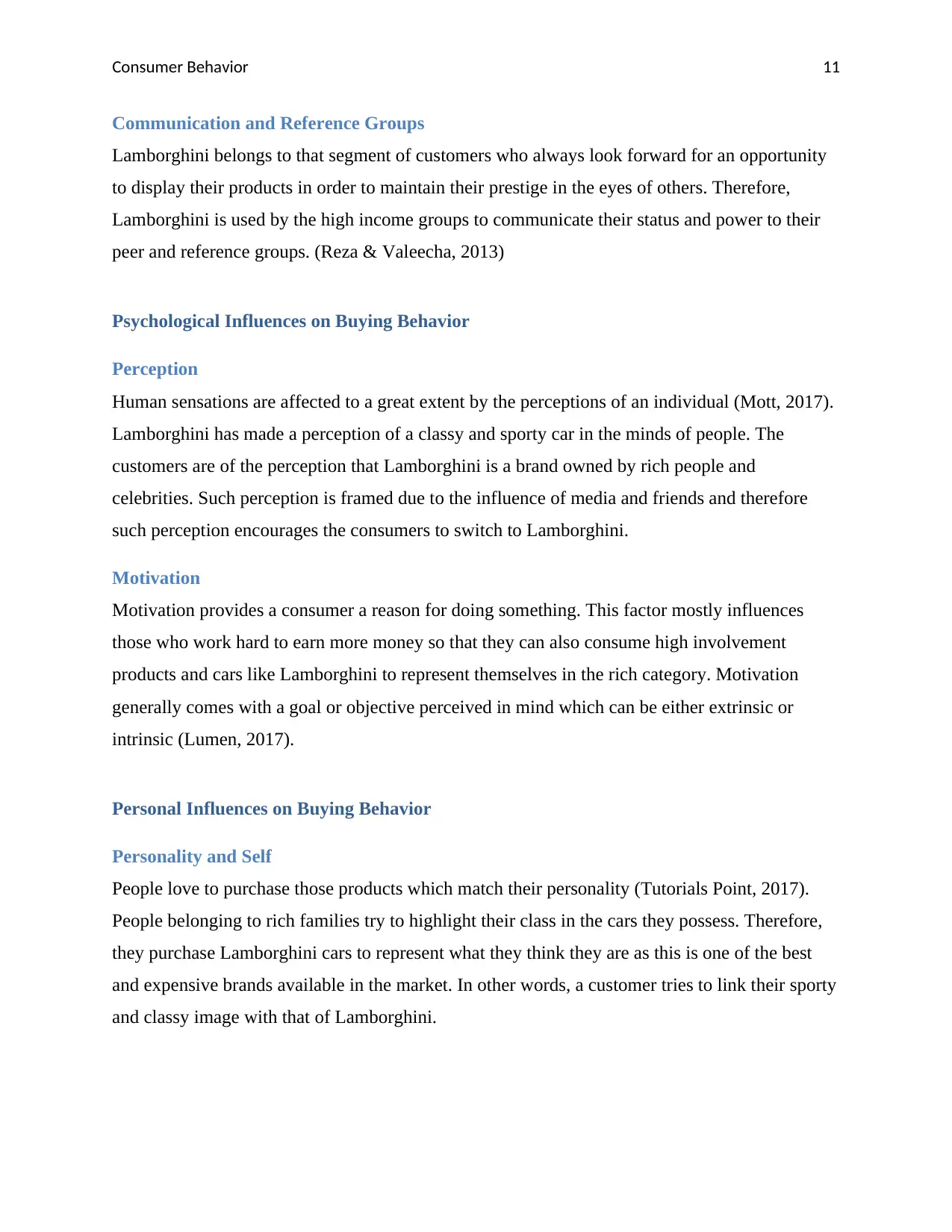
Consumer Behavior 11
Communication and Reference Groups
Lamborghini belongs to that segment of customers who always look forward for an opportunity
to display their products in order to maintain their prestige in the eyes of others. Therefore,
Lamborghini is used by the high income groups to communicate their status and power to their
peer and reference groups. (Reza & Valeecha, 2013)
Psychological Influences on Buying Behavior
Perception
Human sensations are affected to a great extent by the perceptions of an individual (Mott, 2017).
Lamborghini has made a perception of a classy and sporty car in the minds of people. The
customers are of the perception that Lamborghini is a brand owned by rich people and
celebrities. Such perception is framed due to the influence of media and friends and therefore
such perception encourages the consumers to switch to Lamborghini.
Motivation
Motivation provides a consumer a reason for doing something. This factor mostly influences
those who work hard to earn more money so that they can also consume high involvement
products and cars like Lamborghini to represent themselves in the rich category. Motivation
generally comes with a goal or objective perceived in mind which can be either extrinsic or
intrinsic (Lumen, 2017).
Personal Influences on Buying Behavior
Personality and Self
People love to purchase those products which match their personality (Tutorials Point, 2017).
People belonging to rich families try to highlight their class in the cars they possess. Therefore,
they purchase Lamborghini cars to represent what they think they are as this is one of the best
and expensive brands available in the market. In other words, a customer tries to link their sporty
and classy image with that of Lamborghini.
Communication and Reference Groups
Lamborghini belongs to that segment of customers who always look forward for an opportunity
to display their products in order to maintain their prestige in the eyes of others. Therefore,
Lamborghini is used by the high income groups to communicate their status and power to their
peer and reference groups. (Reza & Valeecha, 2013)
Psychological Influences on Buying Behavior
Perception
Human sensations are affected to a great extent by the perceptions of an individual (Mott, 2017).
Lamborghini has made a perception of a classy and sporty car in the minds of people. The
customers are of the perception that Lamborghini is a brand owned by rich people and
celebrities. Such perception is framed due to the influence of media and friends and therefore
such perception encourages the consumers to switch to Lamborghini.
Motivation
Motivation provides a consumer a reason for doing something. This factor mostly influences
those who work hard to earn more money so that they can also consume high involvement
products and cars like Lamborghini to represent themselves in the rich category. Motivation
generally comes with a goal or objective perceived in mind which can be either extrinsic or
intrinsic (Lumen, 2017).
Personal Influences on Buying Behavior
Personality and Self
People love to purchase those products which match their personality (Tutorials Point, 2017).
People belonging to rich families try to highlight their class in the cars they possess. Therefore,
they purchase Lamborghini cars to represent what they think they are as this is one of the best
and expensive brands available in the market. In other words, a customer tries to link their sporty
and classy image with that of Lamborghini.
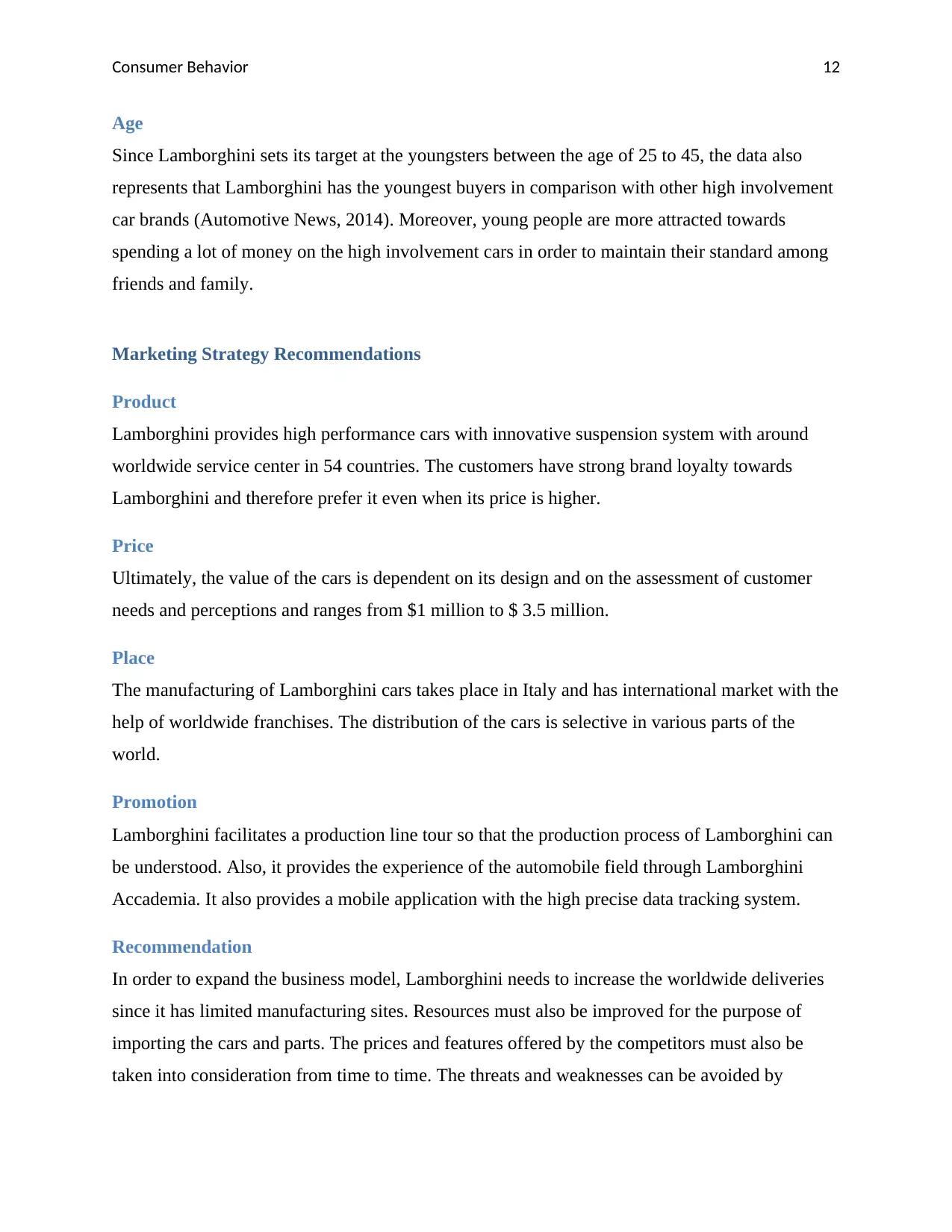
Consumer Behavior 12
Age
Since Lamborghini sets its target at the youngsters between the age of 25 to 45, the data also
represents that Lamborghini has the youngest buyers in comparison with other high involvement
car brands (Automotive News, 2014). Moreover, young people are more attracted towards
spending a lot of money on the high involvement cars in order to maintain their standard among
friends and family.
Marketing Strategy Recommendations
Product
Lamborghini provides high performance cars with innovative suspension system with around
worldwide service center in 54 countries. The customers have strong brand loyalty towards
Lamborghini and therefore prefer it even when its price is higher.
Price
Ultimately, the value of the cars is dependent on its design and on the assessment of customer
needs and perceptions and ranges from $1 million to $ 3.5 million.
Place
The manufacturing of Lamborghini cars takes place in Italy and has international market with the
help of worldwide franchises. The distribution of the cars is selective in various parts of the
world.
Promotion
Lamborghini facilitates a production line tour so that the production process of Lamborghini can
be understood. Also, it provides the experience of the automobile field through Lamborghini
Accademia. It also provides a mobile application with the high precise data tracking system.
Recommendation
In order to expand the business model, Lamborghini needs to increase the worldwide deliveries
since it has limited manufacturing sites. Resources must also be improved for the purpose of
importing the cars and parts. The prices and features offered by the competitors must also be
taken into consideration from time to time. The threats and weaknesses can be avoided by
Age
Since Lamborghini sets its target at the youngsters between the age of 25 to 45, the data also
represents that Lamborghini has the youngest buyers in comparison with other high involvement
car brands (Automotive News, 2014). Moreover, young people are more attracted towards
spending a lot of money on the high involvement cars in order to maintain their standard among
friends and family.
Marketing Strategy Recommendations
Product
Lamborghini provides high performance cars with innovative suspension system with around
worldwide service center in 54 countries. The customers have strong brand loyalty towards
Lamborghini and therefore prefer it even when its price is higher.
Price
Ultimately, the value of the cars is dependent on its design and on the assessment of customer
needs and perceptions and ranges from $1 million to $ 3.5 million.
Place
The manufacturing of Lamborghini cars takes place in Italy and has international market with the
help of worldwide franchises. The distribution of the cars is selective in various parts of the
world.
Promotion
Lamborghini facilitates a production line tour so that the production process of Lamborghini can
be understood. Also, it provides the experience of the automobile field through Lamborghini
Accademia. It also provides a mobile application with the high precise data tracking system.
Recommendation
In order to expand the business model, Lamborghini needs to increase the worldwide deliveries
since it has limited manufacturing sites. Resources must also be improved for the purpose of
importing the cars and parts. The prices and features offered by the competitors must also be
taken into consideration from time to time. The threats and weaknesses can be avoided by
Paraphrase This Document
Need a fresh take? Get an instant paraphrase of this document with our AI Paraphraser
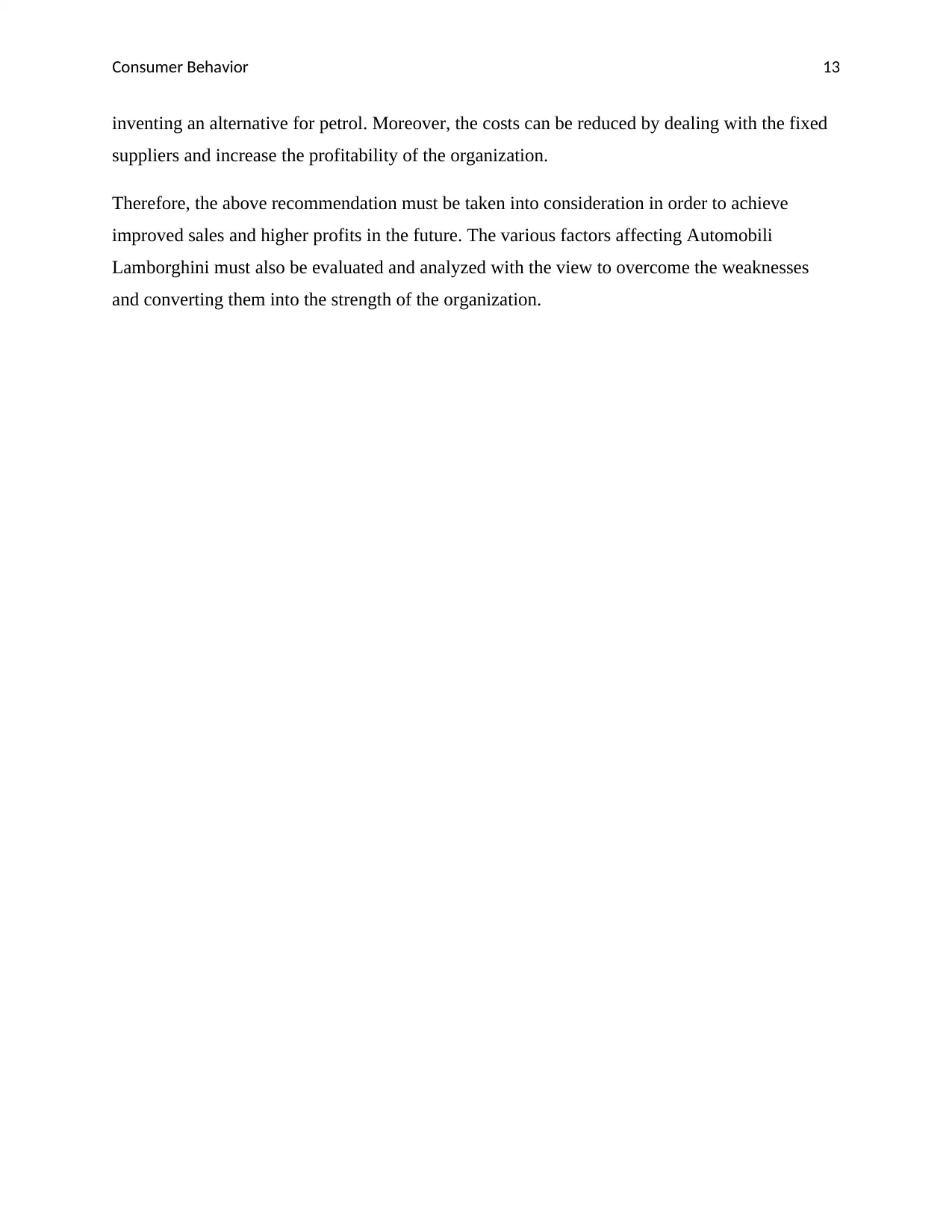
Consumer Behavior 13
inventing an alternative for petrol. Moreover, the costs can be reduced by dealing with the fixed
suppliers and increase the profitability of the organization.
Therefore, the above recommendation must be taken into consideration in order to achieve
improved sales and higher profits in the future. The various factors affecting Automobili
Lamborghini must also be evaluated and analyzed with the view to overcome the weaknesses
and converting them into the strength of the organization.
inventing an alternative for petrol. Moreover, the costs can be reduced by dealing with the fixed
suppliers and increase the profitability of the organization.
Therefore, the above recommendation must be taken into consideration in order to achieve
improved sales and higher profits in the future. The various factors affecting Automobili
Lamborghini must also be evaluated and analyzed with the view to overcome the weaknesses
and converting them into the strength of the organization.
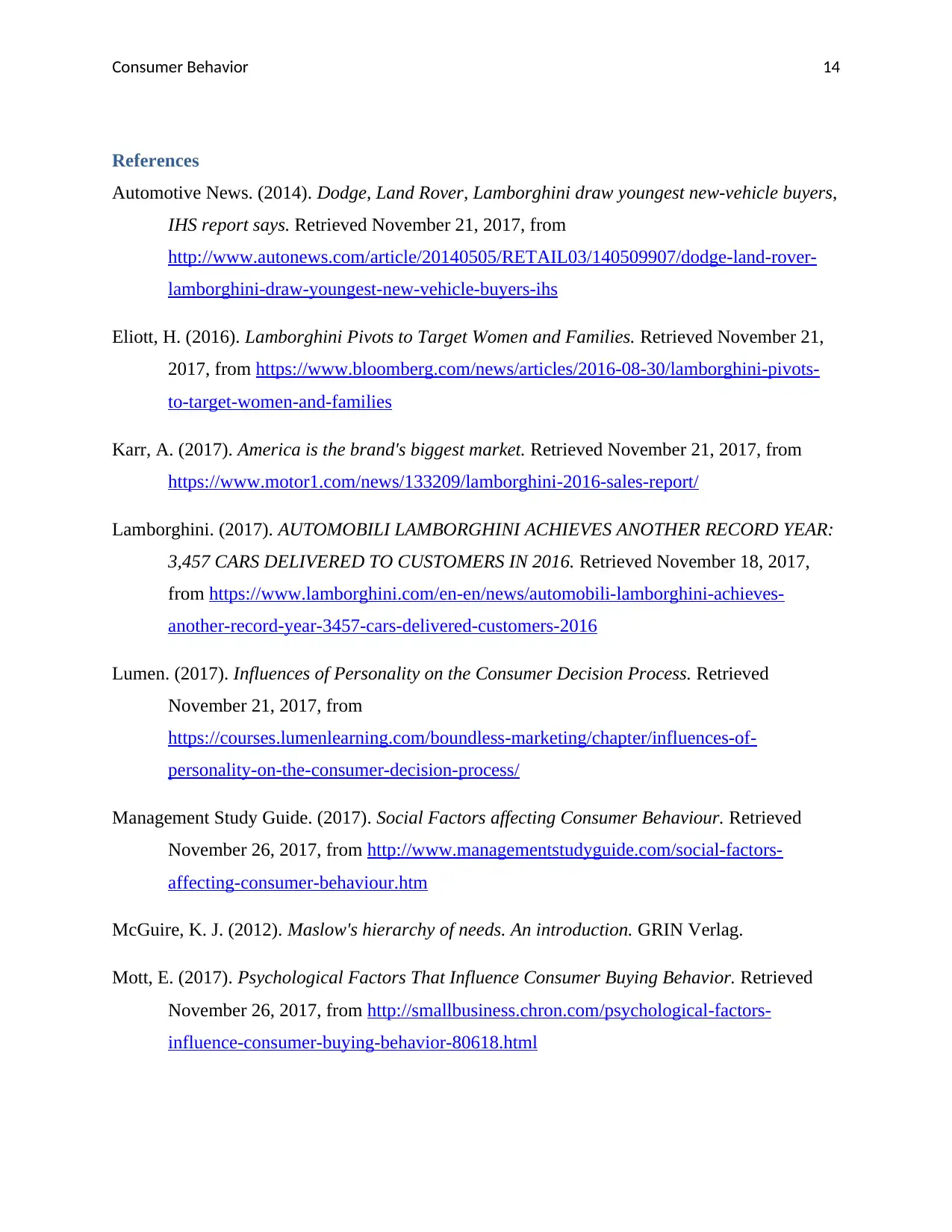
Consumer Behavior 14
References
Automotive News. (2014). Dodge, Land Rover, Lamborghini draw youngest new-vehicle buyers,
IHS report says. Retrieved November 21, 2017, from
http://www.autonews.com/article/20140505/RETAIL03/140509907/dodge-land-rover-
lamborghini-draw-youngest-new-vehicle-buyers-ihs
Eliott, H. (2016). Lamborghini Pivots to Target Women and Families. Retrieved November 21,
2017, from https://www.bloomberg.com/news/articles/2016-08-30/lamborghini-pivots-
to-target-women-and-families
Karr, A. (2017). America is the brand's biggest market. Retrieved November 21, 2017, from
https://www.motor1.com/news/133209/lamborghini-2016-sales-report/
Lamborghini. (2017). AUTOMOBILI LAMBORGHINI ACHIEVES ANOTHER RECORD YEAR:
3,457 CARS DELIVERED TO CUSTOMERS IN 2016. Retrieved November 18, 2017,
from https://www.lamborghini.com/en-en/news/automobili-lamborghini-achieves-
another-record-year-3457-cars-delivered-customers-2016
Lumen. (2017). Influences of Personality on the Consumer Decision Process. Retrieved
November 21, 2017, from
https://courses.lumenlearning.com/boundless-marketing/chapter/influences-of-
personality-on-the-consumer-decision-process/
Management Study Guide. (2017). Social Factors affecting Consumer Behaviour. Retrieved
November 26, 2017, from http://www.managementstudyguide.com/social-factors-
affecting-consumer-behaviour.htm
McGuire, K. J. (2012). Maslow's hierarchy of needs. An introduction. GRIN Verlag.
Mott, E. (2017). Psychological Factors That Influence Consumer Buying Behavior. Retrieved
November 26, 2017, from http://smallbusiness.chron.com/psychological-factors-
influence-consumer-buying-behavior-80618.html
References
Automotive News. (2014). Dodge, Land Rover, Lamborghini draw youngest new-vehicle buyers,
IHS report says. Retrieved November 21, 2017, from
http://www.autonews.com/article/20140505/RETAIL03/140509907/dodge-land-rover-
lamborghini-draw-youngest-new-vehicle-buyers-ihs
Eliott, H. (2016). Lamborghini Pivots to Target Women and Families. Retrieved November 21,
2017, from https://www.bloomberg.com/news/articles/2016-08-30/lamborghini-pivots-
to-target-women-and-families
Karr, A. (2017). America is the brand's biggest market. Retrieved November 21, 2017, from
https://www.motor1.com/news/133209/lamborghini-2016-sales-report/
Lamborghini. (2017). AUTOMOBILI LAMBORGHINI ACHIEVES ANOTHER RECORD YEAR:
3,457 CARS DELIVERED TO CUSTOMERS IN 2016. Retrieved November 18, 2017,
from https://www.lamborghini.com/en-en/news/automobili-lamborghini-achieves-
another-record-year-3457-cars-delivered-customers-2016
Lumen. (2017). Influences of Personality on the Consumer Decision Process. Retrieved
November 21, 2017, from
https://courses.lumenlearning.com/boundless-marketing/chapter/influences-of-
personality-on-the-consumer-decision-process/
Management Study Guide. (2017). Social Factors affecting Consumer Behaviour. Retrieved
November 26, 2017, from http://www.managementstudyguide.com/social-factors-
affecting-consumer-behaviour.htm
McGuire, K. J. (2012). Maslow's hierarchy of needs. An introduction. GRIN Verlag.
Mott, E. (2017). Psychological Factors That Influence Consumer Buying Behavior. Retrieved
November 26, 2017, from http://smallbusiness.chron.com/psychological-factors-
influence-consumer-buying-behavior-80618.html
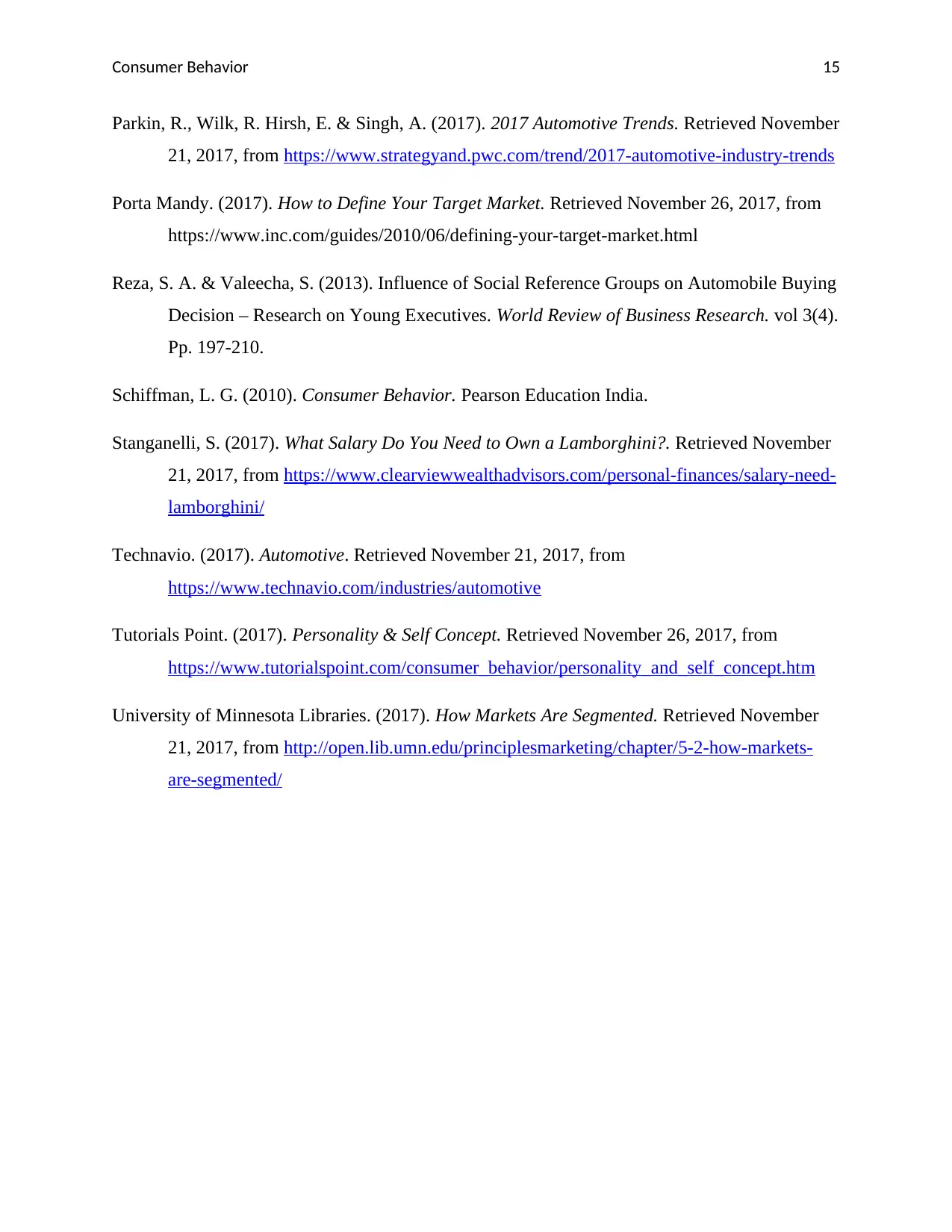
Consumer Behavior 15
Parkin, R., Wilk, R. Hirsh, E. & Singh, A. (2017). 2017 Automotive Trends. Retrieved November
21, 2017, from https://www.strategyand.pwc.com/trend/2017-automotive-industry-trends
Porta Mandy. (2017). How to Define Your Target Market. Retrieved November 26, 2017, from
https://www.inc.com/guides/2010/06/defining-your-target-market.html
Reza, S. A. & Valeecha, S. (2013). Influence of Social Reference Groups on Automobile Buying
Decision – Research on Young Executives. World Review of Business Research. vol 3(4).
Pp. 197-210.
Schiffman, L. G. (2010). Consumer Behavior. Pearson Education India.
Stanganelli, S. (2017). What Salary Do You Need to Own a Lamborghini?. Retrieved November
21, 2017, from https://www.clearviewwealthadvisors.com/personal-finances/salary-need-
lamborghini/
Technavio. (2017). Automotive. Retrieved November 21, 2017, from
https://www.technavio.com/industries/automotive
Tutorials Point. (2017). Personality & Self Concept. Retrieved November 26, 2017, from
https://www.tutorialspoint.com/consumer_behavior/personality_and_self_concept.htm
University of Minnesota Libraries. (2017). How Markets Are Segmented. Retrieved November
21, 2017, from http://open.lib.umn.edu/principlesmarketing/chapter/5-2-how-markets-
are-segmented/
Parkin, R., Wilk, R. Hirsh, E. & Singh, A. (2017). 2017 Automotive Trends. Retrieved November
21, 2017, from https://www.strategyand.pwc.com/trend/2017-automotive-industry-trends
Porta Mandy. (2017). How to Define Your Target Market. Retrieved November 26, 2017, from
https://www.inc.com/guides/2010/06/defining-your-target-market.html
Reza, S. A. & Valeecha, S. (2013). Influence of Social Reference Groups on Automobile Buying
Decision – Research on Young Executives. World Review of Business Research. vol 3(4).
Pp. 197-210.
Schiffman, L. G. (2010). Consumer Behavior. Pearson Education India.
Stanganelli, S. (2017). What Salary Do You Need to Own a Lamborghini?. Retrieved November
21, 2017, from https://www.clearviewwealthadvisors.com/personal-finances/salary-need-
lamborghini/
Technavio. (2017). Automotive. Retrieved November 21, 2017, from
https://www.technavio.com/industries/automotive
Tutorials Point. (2017). Personality & Self Concept. Retrieved November 26, 2017, from
https://www.tutorialspoint.com/consumer_behavior/personality_and_self_concept.htm
University of Minnesota Libraries. (2017). How Markets Are Segmented. Retrieved November
21, 2017, from http://open.lib.umn.edu/principlesmarketing/chapter/5-2-how-markets-
are-segmented/
1 out of 16
Related Documents
Your All-in-One AI-Powered Toolkit for Academic Success.
+13062052269
info@desklib.com
Available 24*7 on WhatsApp / Email
![[object Object]](/_next/static/media/star-bottom.7253800d.svg)
Unlock your academic potential
© 2024 | Zucol Services PVT LTD | All rights reserved.





